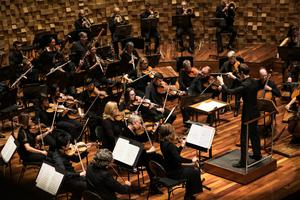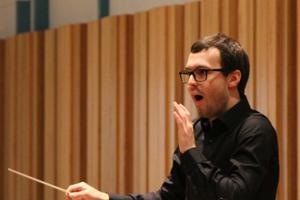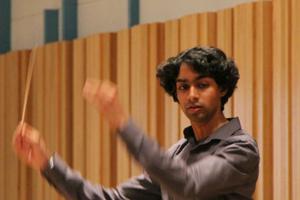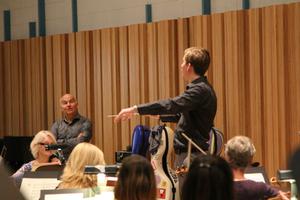The first Australian Conducting Academy was held in Hobart in early 2018, attesting to the strong ties between UTAS' Conservatorium and the state’s top professional orchestra.
Eleven young conductors were selected for the nine-day conducting academy, working closely with the celebrated Tasmanian Symphony Orchestra.

Preparing to perform
The students first had to get through a fiercely competitive application
process. Once selected, they were in for an intense and surprisingly
wide-ranging course. "We had yoga and mime
classes, to help us loosen up and to perfect the gestures that are used in
conducting,” said Riley O’ Doherty (Master of Music Performance, Saxophone and
Clarinet).
Students then rehearsed with the piano, before graduating to work with the orchestra.
“I’d done an Honours program on conducting technique, but it’s something completely different to work with a real deal orchestra," said Riley. "It’s absolutely terrifying, but they were really good to us and gave us excellent feedback.”

A world-class opportunity
“This collaboration is quite unique in Australia,” says workshop participant, Nathaniel Griffiths. “It’s really important for young conductors to get in front of an orchestra, and to be able to work with such a high calibre orchestra was wonderful – if nerve-wracking.”
Born in Mackay, Queensland, Nathaniel started learning the euphonium at the age of nine. Until June 2017, he was a euphonium and trombone major at the Griffith Conservatorium of
Music and has moved to Hobart in pursuit of a conducting education.
Nathaniel and his fellow students worked under the tutelage of Johannes Fritzsch, who has conducted some of the world’s best orchestras. At the end of the course, the students conducted the TSO in works by Mozart, Debussy, Beethoven and Schubert.
TSO magic

"Hence conductors have to be extremely efficient in trying to realize their scholarly interpretation of the work. I found this faster reaction that a professional orchestra gives one of the most challenging things.”
An eye on the prize
Opportunities to meet and talk with the artistic directors of all the major orchestras in Australia and New Zealand were included in the course. These possible future employers were also invited to watch the final concert. Riley O’Doherty says:
Conducting jobs are fairly rare, and it takes many years of experience and, likely, freelance work, in order to get one. This kind of experience is vital, in order just to get your foot in the door.
Alexander agrees.
“When applying for conducting positions in professional orchestras, they want to see if you’ve had any professional experience.” Since the academy, he has already been able to put that to the test: completing two masterclasses in Berlin with the Berlin Sinfonietta where he was able to apply the experience gained from conducting the TSO at the Academy.
And of the future? All three students will work towards becoming professional conductors. “I don’t mind if it’s for symphonic repertoire, opera, ballet or even for movie soundtracks - it’s all lovely music!” said Alexander.
Apply to study a Bachelor of Music at the University of Tasmania's Conservatorium of Music.
Banner image: Conducting student Nathaniel Griffiths, photo by Matthew Farrell.
Additional images (top to bottom): Nathaniel Griffiths and the orchestra, photo by Matthew Farrell; Nathaniel Griffiths, photo by the TSO; Alexander Rodrigues, photo by the TSO; Johannes Fritzsch watches Riley O'Doherty conduct, photo by the TSO.